2018 has been declared as “Turkmenistan, the heart of the Great Silk Road” by visionary President of Turkmenistan H.E. Gurbanguly Berdimuhamedov. This is derived from the President’s new book “Turkmenistan the heart of the Great Silk Road”. It reflects the concept of modern development of the country based on historical experience, traditions of peace-making and good neighborliness, respect of spiritual heritage, desire for greater regional connectivity and global integration and socio-economic prosperity.
Main Ideas
One of the main ideas of the book is to highlight the soft image of Turkmenistan in terms of its contributory role in the past, supportive measures of the present and of course its future endeavors for a “shared prosperity” in the region and beyond and the its paramount role in the development of Silk Road. Multi-dimensional economic, political, social and geographical importance is also discussed in the book. The Silk Road has been inspirational for traders, businessmen, investors, travellers, students and explorers for the co-existence of civilizations, convergence of cultures, respectfulness of heritages, desire for socio-economic prosperity, caravans of human values and the last but not the least, scientific and cultural connections between the East and the West.
Turkmenistan & Modern Silk Road
It also showcases Turkmenistan’s role in the further development of infrastructural development, transportation, logistics corridors and above all its holistic approach for further regional integration and global pursuits. It shows Turkmenistan’s role in the maintenance of ancient and development of the modern Silk Road (SR). Its great monuments like Ancient Merv, Kunyaurgench and Parthian strongholds of Nisa have been attractions for the people living around the SR in the past.
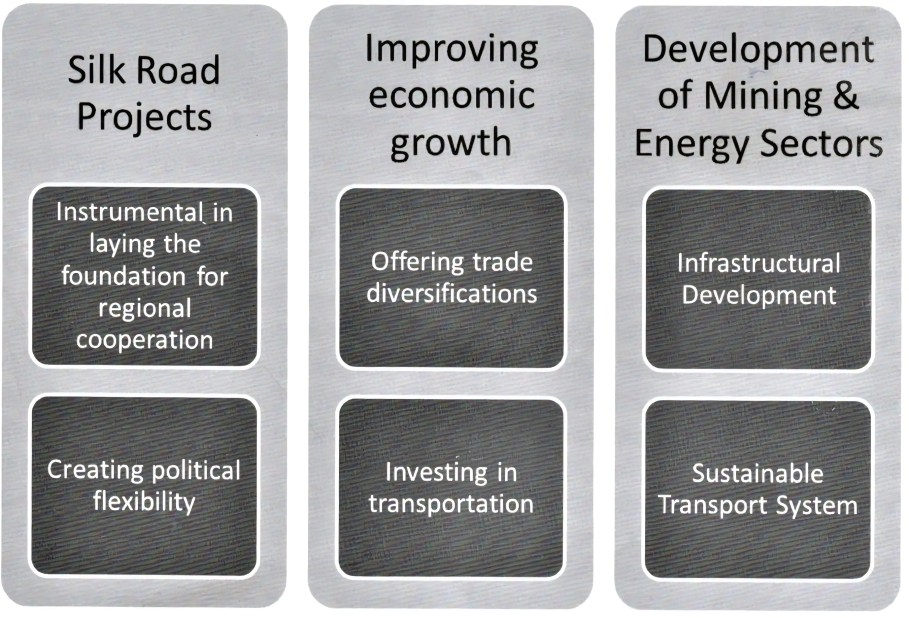
Silk Road: Great Means of Connectivity & Communications
The Silk Road was one of the first trade routes to connect the East and the West. It was important paths for cultural, commercial and technological exchange between traders, merchants, pilgrims, missionaries, soldiers, nomads and urban dwellers from Ancient Turkmenistan, China, India, Tibet, Persian Empire and Mediterranean countries for almost 3,000 years. Extending 11,000 km, the Silk Routes enabled people to transport goods, slaves and luxuries such as silk, satin and other fine fabrics, musk, other perfumes, spices, medicines, jewels, glassware and even rhubarb, as well as serving as a conduit for the spread of knowledge, ideas, cultures, zoological specimens.
The Silk Road was not only the ancient world’s most strategic trade route, but was also the information superhighway of its day, carrying knowledge and ideas between east and west that shaped entire civilizations.
For more than 1,000 years, the Silk Road that ran for 11,000km from the Mediterranean across Asia to China brought east and west together and helped lay the foundations of the modern world. The fabled network circled the planet, until, in the 16th century, it faded into history as ships were able to transport goods cheaper and faster to far-off Cathay than over the hazardous land route that crossed some of the world’s most inhospitable terrain.
The government of Turkmenistan is doing a great job for the revival of the new Silk Road by investing in the above mentioned parameters of human survival and productive channels.
New Silk Road Initiatives
The New Silk Road initiatives or development large and small scale, bilateral and multilateral, governmental and private upholds a positive climate for building a new trade and exchange system that could bring prosperity to Central Asian states much like the historic Silk Road in which Turkmenistan can play a major role because of its strategic geographic comparative advantage in the region.
Silk Road has been famous for excellent means of connectivity and convergence, selling of goods and sharing of knowledge, meeting of caravans and centers of comforts, exchanging of cultures and experiences of spiritual values, showcasing of development and discoveries, and the ideal combination of statesmanship and craftsmanship. It connected Asia, Europe and the Mediterranean Sea. The Silk Road was monumental in developing cultures and civilisations throughout South East Asia and Central Asia.
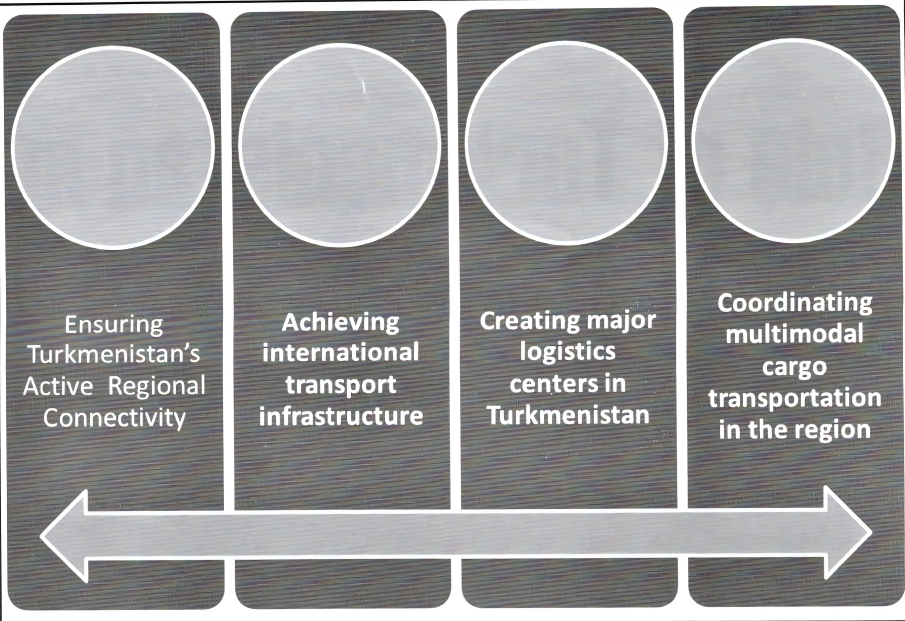
Active People & Economic Diplomacy
The Silk Road has also been known for active people diplomacy which was latterly submerged into economic diplomacy. Turkmenistan has been pioneer in achieving better understanding of diversified cultures, meanings of survivals, productive channels, political consensus and sustained socio-economic prosperity on the path of Silk Road. It also pledges Turkmenistan’s strong political commitment for its revival in the 21st century. Turkmenistan has been supportive for regional energy cooperation, logistic corridors, mega railways and seaports which may be useful in the effective revival of Silk Road.
Turkmenistan: Connecting Hub
Turkmenistan’s connecting hub status has once again transformed the Silk Road as a bridge between East and West, North and South. Its Air Gates, maritime routes, speedy railways, developed roads and immense infrastructural development has capacity to transform new Silk Road in the 21st century.
It has built railway lines of national and international significance, engineering and technical facilities ensuring prosperity of the country, strengthening its economic might, and developing other areas of national economy.
Modern Turkmenistan & Modern Silk Road
Now Turkmenistan stands for superior human values, unmatched social development, and economic prosperity. Its railway transport plays very important role in its macro-economy. For reviving of Silk Road, major international projects have been carried out; railway terminals, depots, train stations and relevant infrastructure facilities have been built and commissioned within give time frames.
These measures help improve the quality of transportation services in Turkmenistan and its adjacent countries especially Afghanistan, Iran, Kazakhstan, Azerbaijan and Uzbekistan. For further strengthening of Silk Road Initiatives, Turkmenistan has widened its meaningful commercial and economic partnership with the neighboring countries. It pursues the policy of peacefulness, humanism and constructive cooperation with the countries around the globe and establishes transcontinental rail corridors in the sphere of transport and logistics.

Importance of Bereket Locomotive Depot
It has been has been built along the international transport corridor, Kazakhstan-Turkmenistan-Iran, that is to link the countries of the regions to ports on the Persian Gulf via the shortest route. Commissioning of this new facility will promote our country’s reliable functioning as a transport and transit hub. The Bereket Locomotive Depot links its railway network with North-South and East-West routes will help upgrade transportation services to a higher level.
Turkmenistan’s Aim
This is also important in the context of reviving the Great Silk Road in the modern format and its efficient operations. During the years of independence, tremendous work has been carried out to develop the domestic railway transportation industry: logistics and supply base enhanced and modern infrastructure created. Works in the due course are continuing.
Turkmenistan: Silk Road & Globalization
The Silk Road signifies Turkmenistan’s approach to globalisation and has the potential to reshape global trade. It is a growth oriented mega project. This is particularly important for Less Economically Developed Countries (LEDCs) as well as Double Land Lock Countries like most of the CIS this new initiative allowed Turkmenistan to break its reliance on Russia and trade more freely.
Also, the new Silk Road will boost the economies of participating countries. The private sector will invest more and more as the Silk Road improves. It will, in turn, provide opportunities for growth to businesses and better access to goods for people worldwide.
Global Partnership
Turkmenistan is blessed with unlimited reserves of natural gas which utilizes for greater regional as well as global partnership for development. It implements the policy of diversification of its international cooperation, particularly in the energy sector, on the basis of an equal partner access to the sources of Turkmen hydrocarbons and their means of delivery. It involves the creation of multivariate transportation pipeline infrastructure on the conclusion of Turkmen energy resources to international energy markets.
Turkmenistan Gas Corridors
Turkmenistan’s unique position in Central Asia today banks on its status as a major producer and exporter of natural gas. Turkmenistan exports 44 billion cubic meters (bcm) of the 77 bcm it produces each year.
Development of Turkmenistan’s gas corridors are designed for long-term supply of natural gas, and create conditions for the fulfillment of international agreements on natural gas supplies, which contribute to the successful implementation of the national energy strategy for the stable transportation of energy resources to world markets and of course transform the Silk Road in 21st century by achieving greater regional as well as global energy cooperation.
Currently, in Turkmenistan is operated the main export gas pipelines which are given below in the diagram showing diversified but integrated gas supplies of Turkmenistan. It also showcases Turkmenistan’s diversification energy policy which has reduced its reliance on other. It projects Turkmenistan’s strong political commitment and economic investments for the further development of the Silk Road.
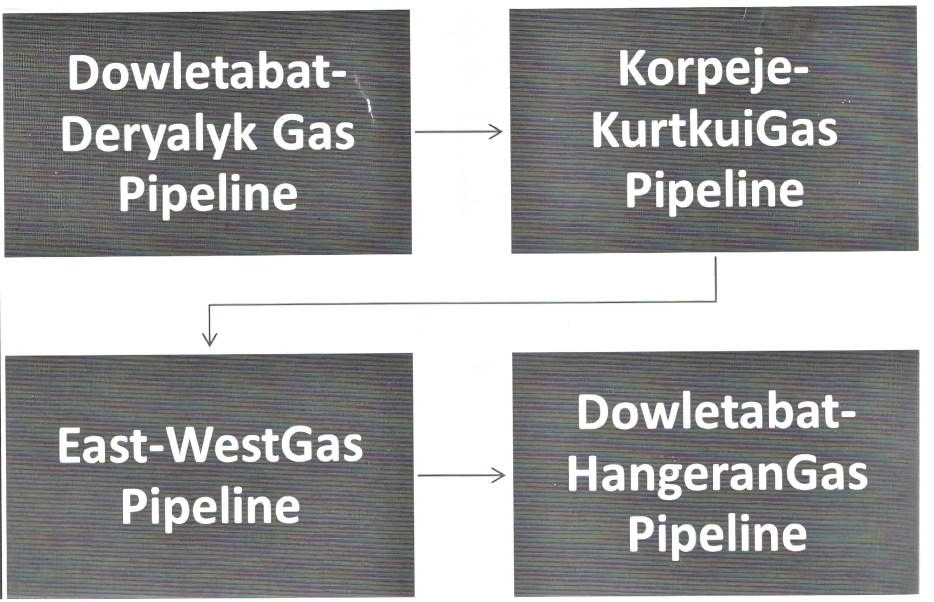
Corridors of Convergence
Turkmenistan’s gas pipelines are corridors of convergence not hegemony, development not disintegration, prosperity not poverty, production not recession and gift not compulsion to the region as well as the globe. Turkmenistan has great geographic position in the Silk Road owing to which its government is doing great job for its revival, suitability, profitability and development in which its mega gas pipelines are playing contributory role.
| Turkmenistan-Uzbekistan-Kazakhstan-China Gas Pipeline | Kilometers |
| Uzbekistan | 490 |
| Kazakhstan | 1304 |
| China | 7000 |
Turkmenistan-Uzbekistan-Kazakhstan-China Gas Pipeline
The total length of the pipeline, originating from the field Malay and the fields on the right bank of Amudarya river is more than 9000 kilometers.
It routes to major industrial centers such as Shanghai, Guangzhou, Hong Kong and others where the gas is distributed to other existing gas networks.
Turkmenistan-Uzbekistan-Kazakhstan-China Gas Pipeline is now paying its dividends in terms of greater regional energy cooperation, energy security, energy price stability, greater industrialization, development of productive channels and realization of climate change in these connecting countries. Silk Road is the icon of connectivity and Turkmenistan’s gas corridors are rebirthed it in the 21st century.
It was inaugurated on December 14, 2009. Currently 3 branches of Turkmenistan-China (Branches A, B, C) with a total capacity of 55 billion m3 per year are being built. This stage of the pipeline is designed to supply 40 billion m3 of Turkmen gas per year.
Dovletabad-Deryalyk Gas Pipeline
It is operated by State Concern Turkmengaz which provides the export of Turkmen natural gas from the eastern and western gas production regions of Turkmenistan in the northern direction and includes pipelines system of Dowletabat-Deryalyk.
| Dovletabad-Deryalyk Gas System | Technology Inputs |
| Nayip-Deryalyk | Diameter 220 mm, 1020 mm & Length 942 km |
| Dowletabat-Deryalyk | Diameter 1420 mm, 1220 mm & Length 3244.2 km |
| Bukhara-Ural | Diameter 1020 mm & Length 238.6 km |
| Ekerem-Bekdash | Diameters 530 mm, 720 mm and 1,020 mm & Length527 km to the border of Turkmenistan-Kazakhstan |
Korpeje-Kurtkui Gas Pipeline
This was operationalized in December 1997, its length from the Turkmen gas field Korpeje to the Iranian city Kurtkui is 197 km, of which the length of the gas pipeline on the territory of Turkmenistan is 132 km. On this route gas is exported to the northern provinces of Iran under the purchase and sale contract of natural gas between the State Concern Turkmengaz and Iranian Gas Company. The annual volume of deliveries on this pipeline is 8 billion cubic meters of gas per year.
Dovletabad-Sarahs-Hangeran Gas Pipeline
It was opened in January 2010. The length of the Turkmen section of the gas pipeline, which originates from the largest gas field Dovletabat in the south-eastern Turkmenistan, to the settlement Salyr Yap on the border with Iran is 30.5 km. It has capacity to deliver 12.5 billion m3 of gas per annum. Together with the existing main gas pipeline Korpeje-Kurtkui pipeline Dovletabad-Sarahs-Hangeran provides supply contract volumes of gas to 14 billion m3 per year, and in the future may increase up to 20 billion m3/year of Turkmen gas to Iranian consumers.
East-West Gas Pipeline
Carried out by State Corporations Turkmengaz and Turkmennebitgazgurlushyk, this has length of approximately 773 kilometers, with a diameter of 1,420 mm and a design annual capacity of 30 billion cubic meters. Along the route of the gas pipeline project is stipulated the construction of several gas compressor stations and other infrastructure. In December 2016 the ceremony of laying the pipeline took place. It establishes from the compressor station Shatlyk in Mary province, and connects the large deposits of east of the country with its western regions. Its final destination is Belek in Balkan province.
It will expand the gas transport infrastructure of Turkmenistan and will contribute to the integral formation of system of gas provision to the metallurgical plant in Ruhabat, textile complex, enterprises producing construction materials, industrial sectors in Abadan.
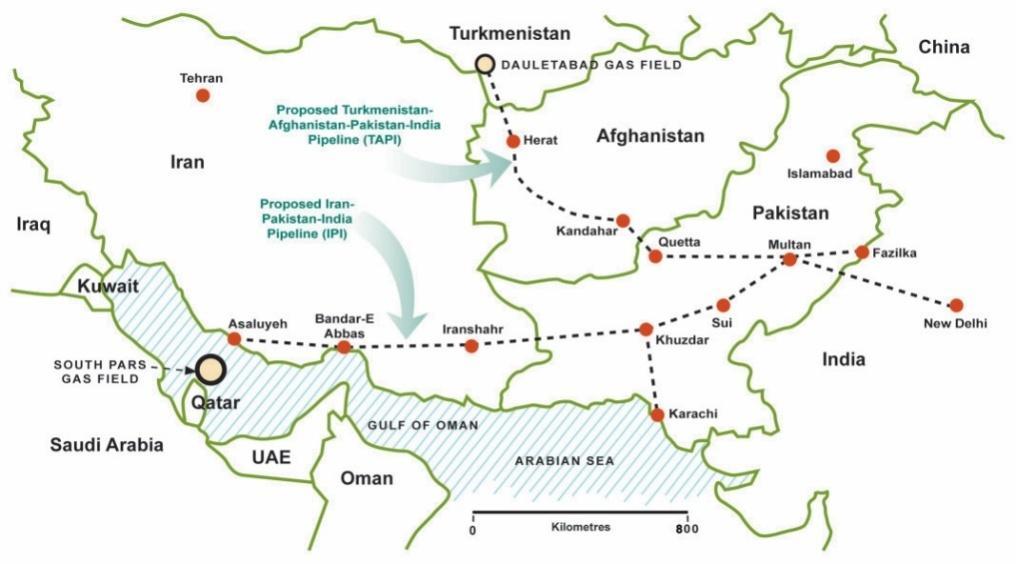
Turkmenistan-Afghanistan-Pakistan-India Gas Pipeline (TAPI) Transcontinental Gas Project
It is a mega, transcontinental gas project which is a gift from Turkmenistan which offers its easy and smooth gas supplies at the cheapest rates to all the members’ countries. It is the gas pipeline of socio-economic integration, political stability in which private sector can play its contributory role. It will export 33 billion cubic meters of Turkmen natural gas per year for 30 years for consumers of Afghanistan, Pakistan and India.
It is being constructed within Turkmenistan by Turkmengaz andTurkmennebitgazgurlushyk.
| TAPI | Territorial Share |
| Turkmenistan | 214 km |
| Afghanistan | 774 km |
| Pakistan | 826 km |
Trans-Caspian gas pipeline
Turkmenistan signed a Memorandum of Understanding and Cooperation in the energy sector with the European Union in 2008 All parties agreed to cooperate on market diversification and supply of energy resources in order to ensure energy security.
Construction of Trans-Caspian gas pipeline project was discussed between President Gurbanguly Berdimuhamedov and Chairman of the European Commission José Manuel Barroso, during his official visit to Turkmenistan on January 15, 2011. It was agreed to establish a working group to work on the Project.
The first negotiations on the Project at the ministerial level between Turkmenistan, the European Commission and the Republic of Azerbaijan were held on March 9, 2011 in Frankfurt. The last ministerial meeting took place in 2012 in Ashgabat to discuss the basic conditions of the Framework Agreement between Turkmenistan and the European Union and Republic of Azerbaijan.
In November 2013 a bilateral meeting was held in Brussels with representatives of the European Commission on Trans-Caspian gas pipeline and exit of Turkmen natural gas to the European market.
Economic/ Business Corridors
Turkmenistan’s various gas pipelines are economic/ business corridors which generate greater economic activity, this highlights the importance of transport communication and further development of the Silk Road for which the government of Turkmenistan is taking all possible measures to get connected with the regional countries.
Shared Prosperity
Development of Turkmenistan’s gas pipelines is based on the concept of shared prosperity which will further strengthen revival of Silk Road in the days to come. It carried out mega structural diversification of the energy sectors which is being gradually implemented through the creation of new, primarily process industries, based on hydrocarbon raw material. Turkmenistan believes that the joint implementation of international transport projects in Central Asia and the Caspian basin are also important, taking into account the unique geographical location in the region and development of the Silk Road.
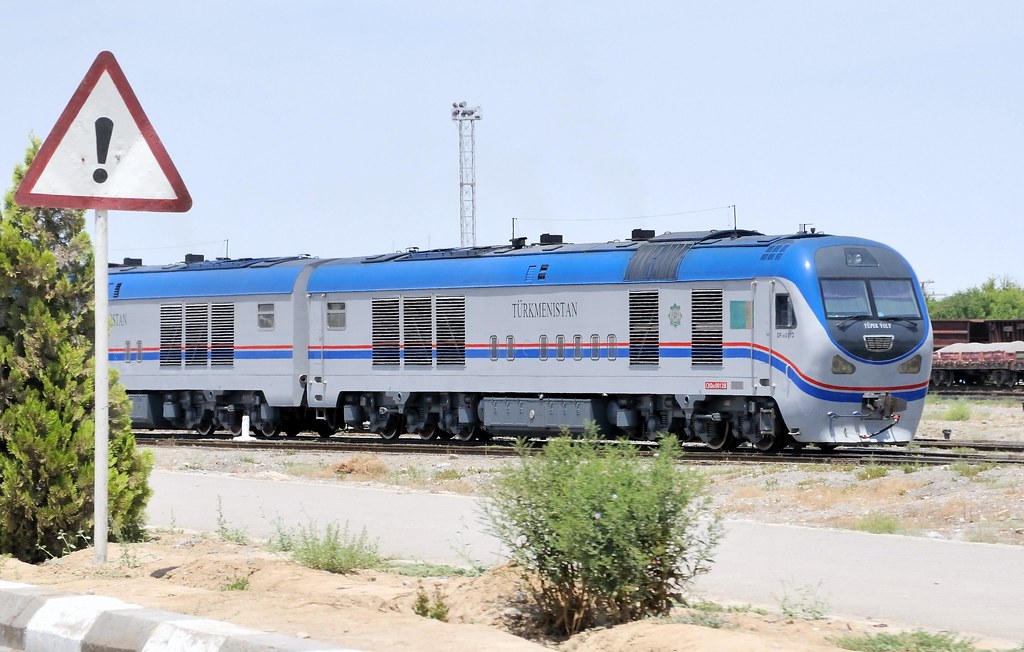
Turkmenistan’s Railways Corridors
According to Turkmenistan’s figures the length of railways in Turkmenistan is 3,080 kilometers. Over the years of independence, it has increased by 900 kilometers. New railway lines have been constructed: Tejen-Sarahs, Turkmenabat-Atamurat, Dashoguz-Koneurgench, Ashgabat-Karakum-Dashoguz. Turkmenistan is one of the largest international transit centers of railway transportation by the lines of “North-South,” “West-East.”
Turkmenistan was the first among the countries of the region to demonstrate at the end of the last century qualitative new approaches for the revival of the ancient Silk Road. The striking example is commissioning of an international railway (Tedjen-Serahs-Meshed) in May 1996, which opened for the countries of Central Asia the shortest way to the transport networks of Iran, Turkey, the Middle East and the Far East.
The economic growth and importance of the railway sector and investments allocated to the development and modernisation of railway infrastructure are no longer a secret and countries in Central Asia are fully aware of this and allocate investments to railway projects. The development of interstate connections through railway lines is a strong point in the consolidation and extension of the economic, political and commercial relationships. The initiatives of the President of Turkmenistan to develop effective transport routes between the Caspian, Black and Baltic Seas are being carried out. It has also formed the transport network bringing together regions of Central, South and Southeast Asia with the Middle East and the Mediterranean. The practical implementation of these ideas comes to life through the construction of new railways and motor roads and the activation of sea routes in Turkmenistan which are catalyst for the revival and further development of the Silk Road.
Turkmenistan: North-South Railway Project
Turkmenistan invests heavily in infrastructure linking up to current developments.
Turkmenistan-Kazakhstan-Iran Railway Line
Operationalization and channelization of the transnational railway corridor (Kazakhstan-Turkmenistan-Iran) aims to provide convenient and cost-effective delivery of cargoes from Europe to Central Asia, South Asia and the Middle East. Commissioning of this railway corridor is also relevant given its connection to the East-West transport network, that is, the transcontinental route (China-Central Asia-Caucasus-Europe), which runs through Turkmenistan and the Caspian Sea. Thecost-effective railway route to stimulate the strengthening of regional cooperation in the field of trade contributes to the realization of the transit potential of Turkmenistan.
The longest section of the Kazakhstan-Turkmenistan-Iran railway line has a length of about 1,000 kilometers. It will connect a large number of countries and regions in the North, West and East Eurasia and the South of the continent with the shortest and most economical routes. It is the new gate to Asian Countries. It was started in 2009 linking the three countries on the route Uzen (Kazakhstan)-Kyzylkaya- Bereket-Etrek (Turkmenistan)-Gorgan (Iran). It is a strategic mega project which connects Central Asia to the Persian Gulf, via Iran. The railway will also facilitate the access of European countries (direct route) to the ports of the Persian Gulf.
| Turkmenistan-Kazakhstan-Iran Railway Line | Technology Inputs |
| Turkmenistan | 700 km |
| Kazakhstan | 130 km |
| Iran | 70 km |
| Total Length | 900 km |
It is predicted that the Turkmenistan-Kazakhstan-Iran Railway Line will increase trade by around USD 10 Billion. The route is three times shorter than that to the Suez Canal and plays an important role in creating new commercial and social environments in the region near the Caspian Sea and north territories from Bereket to the border with Kazakhstan. It is another giant step towards the revival and further development of the Silk Road.
Currently the transit capacity of the project is 3 million tons per year, or a third of final capacity. The project would become fully operational after the trains are electrified and some other work carried out in northern mountainous regions.
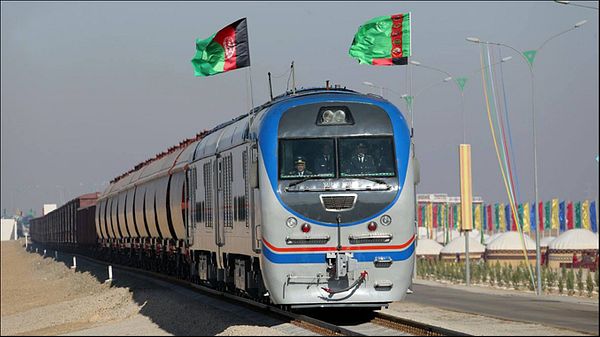
Turkmenistan-Afghanistan-Tajikistan Railway Line
Turkmenistan-Afghanistan-Tajikistan railway is operational and has access to an extensive rail network of China and through it to the rapidly developing countries of the Asia-Pacific region. The Turkmenistan-Afghanistan-Tajikistan Railway Line forms an east-west strategic transportation logistics route in the region, linking the Caspian Sea to China and complementing the north-south corridor. It is designed to serve as a link between the Central Asian region and South Asia. It was inaugurated in June 2013 and its main objectives were to develop a rail corridor linking Central Asia with global markets by providing them easy and efficient access to the Indian Ocean. The 635 kilometer railroad runs through Attamurad and Imamnazar in Turkmenistan, Aqina, Andkhoy, Sheberghan, Mazar-e-Sharif, Khulm, and Kunduz in Afghanistan Section and finally Panjpayan and Kolkhozabad in Tajikistan, with a total estimated cost of around $2 billion. Turkmenistan opened its completed railway link with Afghanistan on November 28, 2016.
Economic Multiplier Effects
It has multiplier effects for all three countries. The Afghan and Tajik economies are suffering a great deal due to their isolated, landlocked status, poor infrastructure, and slow economic growth. Afghanistan’s transport infrastructure was destroyed over the course of decades of war and there is a need to rebuild this infrastructure to benefit from the country’s trade and transit potential. Afghanistan shares borders of 744 and 1,206 kilometers with Turkmenistan and Tajikistan respectively but trade among three countries has remained very low due to poor transport infrastructure. The construction of railway tracks would play a major role in increasing trade and could enable Afghanistan to play the role of a bridge integrating the Central Asian region with global markets.
According to ADB (2016), if basic improvements were to be made to the transportation infrastructure connecting Central Asia to Afghanistan, the overall trade would increase by $12 billion, a growth of 80 percent. Another study by ADB reveals that completing new roads would boost total trade among Afghanistan’s neighbors by 160 percent, increasing the transit trade through Afghanistan by 113 percent.
Turkmenistan-Afghanistan-Azerbaijan-Georgia-Turkey Transportation Logistics Route
Turkmenistan is also looking at the Afghanistan-Turkmenistan-Azerbaijan-Georgia-Turkey transportation logistics route. It was formalised in Ashgabat in November 2014 when a draft agreement was signed. The rail freight route in Central Asia connects Turkmenistan and Afghanistan to the Black Sea, opening up European markets and greater cross-regional trading opportunities.
Turkmenistan’s Transit Corridors
Another important transportation project, a transit corridor is Turkmenistan-Uzbekistan-Iran-Oman has also been under spotlight. Even India has acceded it and ready to join this mega transit corridor. Pakistan has also decided to join it.
Sea freight shipments at the coast will be made possible via the Ashgabat Agreement too. Omani ports will include Salalah Port, Duqm Port and Sohar Port. Iran of course will be looking to maximise developments also sponsored by India at Chahbahar, as well as including Bandar Abbas and Jask in negotiations
Turkmenistan is the Depository State of Ashgabat Agreement, which has Oman, Iran, Turkmenistan and Uzbekistan as founding members. Kazakhstan has also joined this arrangement. The Ashgabat Agreement envisages establishment of International Transport and Transit Corridor between Iran, Oman and Turkmenistan which is being under completion.

TRACECA
Central Asia’s participation in the Transport Corridor Europe-Caucasus-Asia (TRACECA), an international transport program which includes the EU and 14 Eastern European, South Caucasus and Central Asian states has huge potential for opening up markets on an unprecedented scale. It is hoped that collectively, these rail and sea freight networks have the potential to significantly reduce cargo transportation times and make Turkmenistan an important player in the region.
Turkmenistan’s New Air-Gates & Silk Road
The Ashgabat International Airport has become the largest in Central Asia and occupies almost 1,200 hectares and includes more than 100 facilities. It is a new air gate of Turkmenistan which has already brightened the scope and utility of Silk Road in the region and beyond. It has also glorified ancient Silk Road into a modern Silk Road via air.
New Turkmen Caspian Seaport
Turkmenistan is also building a new shipyard at the Caspian port in Turkmenbashi in 2017. The project of the new international sea port in Turkmenbashi envisages the construction of ferry, passenger and container terminals. The complex will include a general loading terminal, a terminal for bulk cargo as well as shipbuilding and ship repairing plants.
Turkmenistan‘s New Turkmen Caspian Seaport & Silk Road Development
Turkmenistan is at the crossroad of Europe and Asia, with a convenient geographical location on the new Silk Road. Rich natural oil and gas reserves and a stable political climate allow the country to implement national transport resources for ensuring the Euro-Asian links.
Reputable Name in Regional & International Railways
Turkmenistan is a reputable name in regional and international railways which provides reliable transport and transit connection throughout its territory. Great attention is paid to the development of all types of transport, including automobile, railroad, air and maritime. During its 25 years of independence, new airports, national and transnational railways and autobahns have been built. Turkmenbashy Sea Port and bridges connecting Turkmenistan with neighboring countries are under construction; maritime, air fleets and railroad parks are being regularly supplemented with new means. At the same time, Turkmenistan is developing international cooperation in the transport sphere and initiating the establishment of interstate transport corridors, becoming an important link of transcontinental routes.
President of Turkmenistan H.E. Gurbanguly Berdimuhamedov’s Concept of Transport Cooperation
President of Turkmenistan H.E. Gurbanguly Berdimuhamedov has developed his own concept of cooperation with the international community in the field of transport and thereby made a worthy contribution to the revival of the Silk Road. The main purpose of the concept of the Turkmen leader is to promote regional connectivity by creating a set of appropriate conditions necessary for the intensification and increase of efficiency of the international transport-transit messages.
National Transport Policy
Turkmenistan’s new concept is fully compatible with its national policies of the transport and communications. As a reliable regional transit node, Turkmenistan is ready to strengthen cooperation with other regional countries on various levels and to play an active role in the construction of the Silk Road.

Turkmenistan: A Large International Logistics Hub
Immense growth in transports & logistics sectors of Turkmenistan shows further strengthening of Silk Road initiatives. Freight and passenger services rendered in the transport-communications sector totaled 2 billion 336 million manats in first half of 2017. It reflects growth targets in the context of building a highly efficient transport system aimed to meet the demand for the services, enhance their safety and quality, create investment opportunities, and raise competitive advantage of local freight and passenger carriers in the home and foreign transport services market and further development of Silk Road.
Its potential in transit logistics is particularly impressive given the fact that the longest section of the North-South Transport Corridor, the transnational Kazakhstan-Turkmenistan-Iran railway runs through Turkmenistan, as well as the recently opened modern railway and highway bridges over the Amudarya River, the Atamyrat-Ymamnazar (Turkmenistan)-Aqina (Afghanistan) railway, which is the first phase of the Asian International Railway Corridor). The international Turkmenistan-Afghanistan-Tajikistan corridor, linking the three states’ communications systems, will enable to enjoy a several fold increase in trade turnover between the countries and other states in the Eurasian area.
Turkmenistan’s Sustainable Transport System
Turkmenistan is rapidly developing its transport infrastructure and connects the national and international networks in the southern and eastern directions making easier launching of the Silk Road. It will offer access to major economic centers such as China, India, Pakistan, and other countries of the Asia-Pacific Region. It is also taking vigorous actions to improve its road-transport infrastructure.
To achieve the desired goals of greater regional connectivity its transport sector’s facilities are being upgraded; sectoral enterprises are taking advantage of innovative technologies. New transport routes are being created in the country.
Turkmenistan also develops maritime passenger and goods services as an essential condition for full integration of Central Asian and Caspian Sea countries into the global economic system. Its Turkmenbashi international seaport functions as the region’s largest transit hub. A new port will be built on the Caspian Sea coast in the years ahead to best fit and justify the city’s high status not only as the maritime gateway, also of Central Asia. The terminal’s freight traffic has increased dramatically and when in operation the new international port will be able to handle much greater volumes of goods.
Concluding Remarks
Turkmenistan under President of Turkmenistan H.E. Gurbanguly Berdimuhamedov’s has unique concept of regional energy, transport, transit routes, seaport and aerial cooperation. The President has initiated many diversified but integrated national policies in the fields of energy diversification, sustainable transports system, energy security, de-carbonization and railway corridors owing to which Turkmenistan has become connecting hub in the region as well as world.
The Silk Road is a network of ancient overland trade routes that extended across the Asian continent and connected China to the Mediterranean Sea. For centuries, the Silk Road also enabled the transmission of knowledge and ideas between the Eastern and Western worlds and for its further development and revival role of Turkmenistan is paramount.
At the national level, Turkmenistan has already started implementation of the large-scale programme of creation, development and modernization of transport infrastructure. It is rapidly implementing construction of highways, interchanges and bridges. The International Airport of Ashgabat (2016) has been operationalized and its operations have increased the transit potential of Turkmenistan.

The construction of the International Seaport in Turkmenbashy is underway, a large logistical center at the crossroads of Asia and Europe. It is designed to coordinate the traffic flows using sea and road as well as railway and air transport. At the beginning of this year, the largest road and rail bridges in the region across the Amu Darya River has been operationalized that connects transport main lines of Uzbekistan and Turkmenistan, and significantly accelerate traffic flows in both directions which also reconfirms role of Turkmenistan in the revival and further development of the Silk Road.
Turkmenistan has a long-term transport strategy. It is based on the maximum use of geographical advantages, logistics possibilities and infrastructure to create large transportation hubs of regional and continental importance that are designed to serve the development of close international economic integration and cooperation. Therefore, together with partners, Turkmenistan implements several major international projects in the region. The newly commissioned railway main line Kazakhstan-Turkmenistan-Iran has the capacity to transport up to 10-12 million tons of freight a year which has already brightened the scope and utility of the Silk Road.
Turkmenistan has a comparative advantage in geography which connects Asia with Europe. It gives prime importance to the creation of modern transport systems and closely cooperates with neighbouring countries in the development of regional transport corridors through North-South and East-West. Globally Turkmenistan is a pioneer in many valuable initiatives in terms of climate change, development, human rights, empowerment of women and sustainable transport system. Now it is a leading player in the Silk Road Initiatives and has already initiated broad dialogue on the development of international transport corridors and has sponsored two UN General Assembly Resolutions on these themes, which were adopted in December 2014 and December 2015 with the support of many countries.
Turkmenistan always showed great commitment to actively participate in the global transport dialogue. Moreover, Turkmenistan is ready to speed up and expand this dialogue, filling it with new specific projects and plans. Turkmenistan is primarily guided by its vision of Central Asia as an integral and essential part of modern global development processes in which the Silk Road of the 21st century would be a game changer in the days to come.
For achieving greater regional connectivity, Turkmenistan is willing to closely work with the Shanghai Cooperation Organization (SCO), the Eurasian Economic Union, the CIS and the Organization of Economic Cooperation for tapping the opportunities in the fields of transport for further strengthening of regional cooperation. Turkmenistan needs a “befitting proposition” for configurations of traffic flows in the continent on the basis of clear principles and mutually beneficial partnership.
Turkmenistan has also concrete and comprehensive plans for further energy cooperation, development of renewables (alternative source of energy), reduction of high carbon footnotes, climate change, energy saving, energy security, energy efficiency by introducing new modern technologies, energy investments and stability of international energy markets in order to meet the growing global demand for energy and improvement of the investment climate in the member countries of Energy Charter and to involve other countries in the Charter during its chairmanship of energy charter conference 2017.
The government of Turkmenistan is taking all possible measures for further strengthening of regional energy cooperation with other countries. It is also suggested that there should be a strict observance of the international standards and standards in which the ecological aspect shall act as priority in all the large-scale projects on ensuring global energy security.
Honeymoon between Turkmenistan and the Silk Road is centuries old during which successive governments of ancient Turkmenistan and people loved its paths of learning, cared about its centers of cultures, protected its rich heritages and preserved its splendid essence of regional connectivity and communications. Once again in the 21st century where globalization surpasses elements of prejudice, bigotry and human limitations the visionary President of Turkmenistan H.E. Gurbanguly Berdimuhamedov has declared year 2018 in Turkmenistan as the heart of the Great Silk. It is derived from President’s new book “Turkmenistan the heart of the Great Silk Road” which shows Turkmenistan’s eternal love and carefulness towards the Silk Road. Silk Road is still in the hearts and souls of Turkmen. Its revival and role of Turkmenistan is the concept of “collective development” based on innovations, smarter economies and good governance and Turkmenistan is the best model of “good governance” and human values in the region and beyond. The ancient Silk Road was famous for human values, caravans of intellect and wealth, trade and commerce activities and exchange of knowledge and wisdom, travelers obsession and tranquility of pilgrims, respect for faith and fantasies of nature and care about people and dignity of friendship. The new Silk Road initiatives reflect the concept of modern development of Turkmenistan primarily based on “shared prosperity” and neutrality” which has been used for a common cause i.e. regional cooperation for achieving peace and harmony. Turkmenistan’s role is vital for the development of Silk Road.




